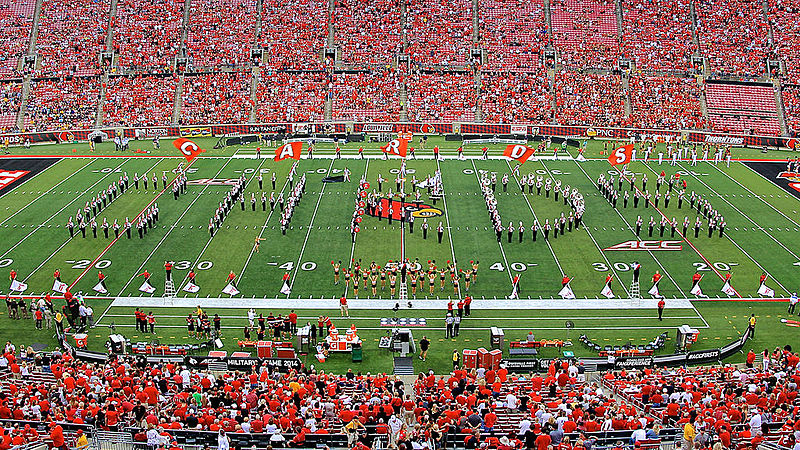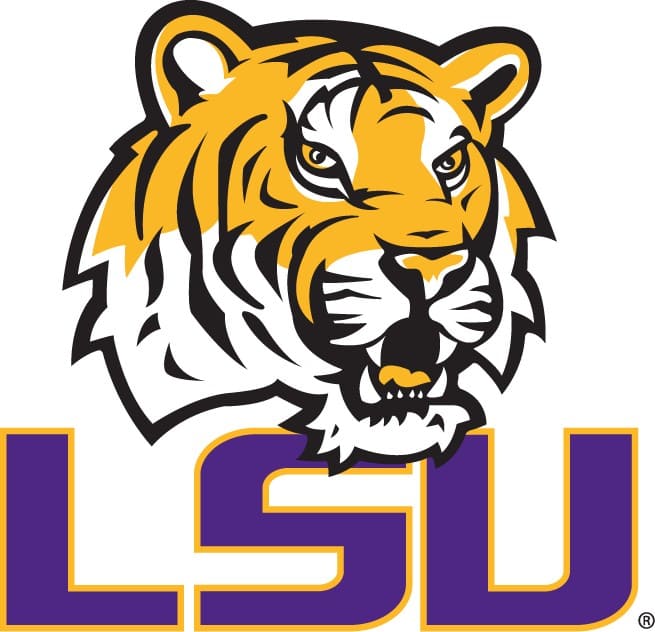Average Size Of Marching Bands

If you’re an outsider to the band world, your assumption on the size of a marching group may come from big college football halftime shows, and be that these groups are always BIG. Or, if you’re from a small town, you may assume that they’re smaller based on what you’ve seen at a local high school football game. The reality is that marching bands come packaged in all sorts of sizes, from the powerhouse collegiate bands to the tightly-knit small school groups and everything in between.
The average size for competing marching bands is around the mid 100s to low 200s. This particular range lends itself well to the competitive-style shows which high schools and drum corps focus on. All in all, marching band sizes vary greatly and can range anywhere from 20-400 members! High schools usually make up the low end and middle of this range, college bands prefer the big numbers, and drum corps has a set number of performers in the middle.
Average Size of High School Marching Bands
In terms of schools, band sizes will most often reflect the school’s size. The average high school marching band can have anywhere from 20-200 members. High schools are given specific classifications based on their size in order to determine competition for sports, in which marching band is included. The classes are ranked from 1A to 6A, 1A being the smallest school enrollment size at around 100 and below and 6A being the largest at over 2.1k. These numbers also vary depending on the state. Texas, for example, has a very competitive and vibrant high school football and marching band culture, (and after all, everything’s bigger in Texas!), and the classes reflect that. The largest high school marching band in the country is in Allen, TX, where the city’s high school with an enrollment of over 5,000 touts a marching band size of almost 900 members!
In Texas terms, a high school classified as 4A can have as few as 60 band members, while a 6A school could have around 120 or more. Really though, there is a lot of variation within classes, and class isn’t always an exact indication of a band’s numbers. Allen HS is still classified as 6A with its 900 member group, and can go up against 6A groups fielding 150 members for contests. Every marching band is different!
Average Size of College Marching Bands
College bands are a bit of a mix of these two criteria. The size of the college will impact the band’s size, but some college bands have a membership limit. The most well-known college marching bands generally field between 300-400 members. Some bands which field 400 or more include The University of Illinois’ “Marching Illini”, The University of North Texas’ “Green Brigade”, and The University of A&M’s “Fightin’ Texas Aggie Band”.
Top College Marching Bands by Size
| College/University | Approximate Marching Band Size | |
 | University of North Texas Green Brigade | 435 |
 | A&M Figthin’ Texas Aggie Band | 400 |
 | Marching Illini | 400 |
| University of Texas Longhorn Band | 380 | |
 | Auburn University Band | 380 |
 | Oklahoma University Pride of Oklahoma | 333 |
 | University of Alabama Million Dollar Band | 330 |
| University of Minnesota Band | 329 | |
 | Louisiana State University Tiger Marching Band | 325 |
 | Penn State Blue Band | 316 |
 | Ohio State University Band | 228 |
Why the large college numbers? Well, this is mainly due to the fact that college bands don’t compete! High school and drum corps groups are tasked with showing off technicality, showmanship, and skill in playing, marching and sometimes dancing. College groups are designed to entertain a football crowd with loud music and fun shows, so large numbers lend themselves to this perfectly.
Average Size of Drum Corps
Similar to high school classifications, drum corps also has various classes based on skill level and age, but unlike high school, there is a membership limit for each class. Drum Corps International has three classes:
- World Class
- Open Class
- Soundsport
As of the 2022 season, all DCI Classes currently have a membership limit of 164.
World Class is the largest and highest skill level class. Although there is no minimum age, the competitive nature of the class lends itself to older and more skilled/experienced members, and demand is high, so these corps are usually closest to (if not right at) the member limit.
Open Class is generally less competitive and a better option for younger/less-experienced members. These corps are usually smaller, averaging about 100 members as of 2020 (dci.org).
Soundsport is smaller than Open Class, but allows woodwinds to march and has no age limit. Soundsport is friendliest for musicians of any skill set and experience level, and can be a good way to warm up to Open Class. All of this to say, Soundsport groups generally average about 50 members.
Small vs. Large Marching Bands: Which Is Better?
There are, of course, benefits to any size marching band. The mid 100s to low 200s is the sweet spot for a competitive marching band, but oftentimes numbers will be above or below this range.
A large band has many benefits. Firstly, everyone loves a loud and powerful band. Having more players makes it easier for the group as a whole to project and blow audience members out of their stadium seats. Secondly, a surplus of members is likely, so directors can put together a more complicated and involved program. If a member is unable to perform for any reason, there are alternates to fill in. With more members, there is also a greater pool of talent to choose from when deciding on show spots or even leadership. Extra members can also be instrumental in moving props around the field and amplifying the visual effects.
On the flip side, big isn’t always better. A small marching band will most certainly cultivate a more tightly-knit and personalized culture than a larger group. Members have more opportunities to get to know others outside of their sections and friend groups; a friendly and familiar atmosphere is an excellent ingredient in the recipe for a talented band. Additionally, since there is more time for each individual marcher, it is easier to give that time to members who need a bit of extra help from staff and leaders.
Finally, it’s important to note that these sizes fluctuate all the time! The addition of new schools in a district, staff changes, recent successes in competition, or even (as we’ve all seen in recent years) a pandemic. However, while group sizes can vary so greatly, there is also no group of any size which doesn’t have the potential for phenomenal performances!